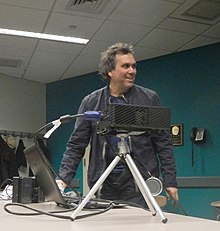Edward Belbruno
Edward Belbruno (born August 2, 1951 in Heidelberg ) is a mathematician who mainly deals with celestial mechanics , dynamic systems, astronomy and space technology.
Life
Belbruno attended Mitchell College and New York University , where he received his bachelor's degrees in mathematics, and received his PhD from the Courant Institute in New York City in 1981 with Jürgen Moser .
From 1985 to 1990 he worked as an "orbital analyst" for the Jet Propulsion Laboratory (JPL) on missions such as Galileo , Magellan, Cassini, Ulysses, Mars Observer.
During this time he laid the foundation for the first systematic application of chaos theory in space travel. This was originally called "fuzzy boundary theory" and describes the movement using only a little fuel to achieve maximum range. In 1990 Belbruno applied his theories to the Japanese lunar probe Hiten , which suffered a malfunction in the transport of the Hagoromo orbiter. Belbruno was able to calculate a ballistic trajectory that required only a small amount of the scarce fuel.
In 1988 Belbruno initially suggested using his low-energy drive on a JPL probe, but met with great skepticism and was in conflict with the probe's engineers. He did not expect any recognition from the Hiten Mission either, although the Japanese were receptive to his ideas. He left JPL in the fall of 1990 for a position at Pomona College.
Belbruno is President and Founder of Innovative Orbital Design Inc., headquartered in Princeton, New Jersey . He was consulted about the rescue of the Asiasat-3 communications satellite, even if a different route to the rescue was ultimately chosen. He is a consultant with NASA and has appeared on NBC Today.
Web links
Individual evidence
- ^ Edward Belbruno, Fly me to the moon: an insider's guide to the new science of space travel , Princeton University Press, 2007.
| personal data | |
|---|---|
| SURNAME | Belbruno, Edward |
| BRIEF DESCRIPTION | American mathematician and space specialist |
| DATE OF BIRTH | 2nd August 1951 |
| PLACE OF BIRTH | Heidelberg |
